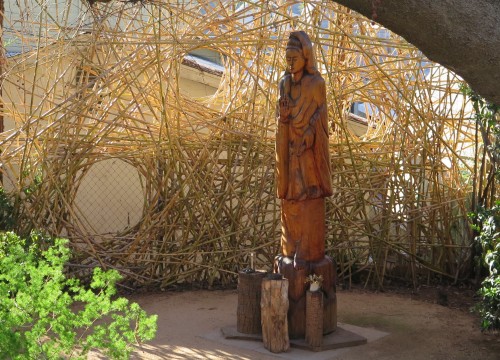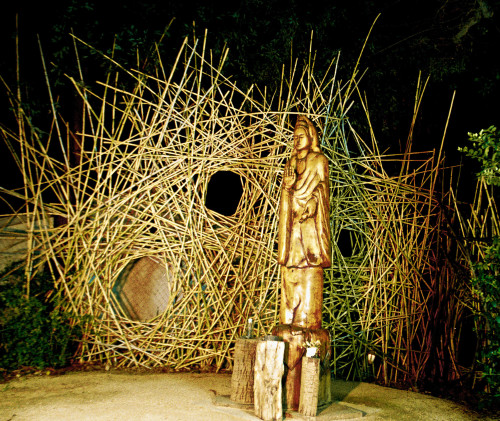For me, Zen practice brings enveloping waves of gratitude—for my teachers, the sangha, our ancestors (dharma and otherwise), loved ones, all living things, and the incomprehensible miracle that within the vast universe there is even such a thing as life and that we get to be a part of it.
It was under the influence of this gratitude that I approached Egyoku Roshi, the abbot of Zen Center of Los Angeles, with a request to give something back to the Mother Temple of the White Plum Lineage. As one who has had the good fortune to practice and study Zen under the guidance of several of Taizan Maezumi Roshi’s students, I wanted to make a contribution to the work of my teachers and sangha, and to the life’s work of the dharma grandfather whom I never met. As an artist, I figured my contribution would be a creative one.
Egyoku Roshi, who is also an artist, embraced the idea. I brought her a pile of images and sketch books, and we walked the ZCLA property, looking to see if there was a suitable spot for an outdoor sculpture. In one corner of the garden there is a very beautiful, tall, wooden statue of Kanzeon [the Bodhisattva of Compassion] by a sculptor named Barbara Yates. The area around the sculpture was scraggly and does not get much sunlight. Roshi picked out a sketch that I had made a year earlier with no location in mind, or even any thought of what it might communicate. And so we defined our project: with the help of the sangha, I would bring that sketch to life in the area surrounding the Kanzeon statue. The sculpture would be about 30 feet long and 20 feet high.

The material I chose for the sculpture is a plant called Giant Reed, or Arundo donax, a bamboo-like member of the grass family. I am part of a local organization that works to protect and enhance the environmental health of the mountains and creeks where we live. Years ago, I was introduced to Arundo donax and its reputation as an invasive plant—a nonnative weed that displaces native species and disrupts healthy ecosystems. I learned that stewards and managers of public and private land all over the country spend millions of (mostly tax) dollars to combat this plant and other “listed” species, almost always using Environmental Protection Agency-approved herbicides like Roundup. I attended meetings of government agencies where Arundo donax was called “evil,” and I wondered, “How can a plant be evil?”
My fellow activists and I tend to be pretty uncomfortable with anything that has a “-cide” in its name, so we decided to investigate before joining the weed wars. We researched the issue for years and came to the following conclusions:
- There are only two legitimate definitions of the word weed: “a plant that I don’t like” and “a plant growing where I don’t want it to grow.”
- Arundo donax grows in temperate climates all over the world. It is one of a growing list of species that people are struggling to control in hopes of preserving habitats and maintaining biodiversity.
- Native and nonnative are anthropocentric terms with no scientific meaning. Plants have been migrating from one place to another since they came into existence, and plant communities are constantly gaining and losing members. This is how nature works. Human efforts to fix an ecosystem are ultimately futile, expensive, and rife with unintended consequences; they are a manifestation of our inability to understand or accept change.
- Some chemicals deemed safe by the EPA have been proven to be incredibly harmful to human and other non-target species, causing damage that can be difficult or impossible to undo. The World Health Organization recently declared glyphosate to be a “likely carcinogen,” while in 2011 alone about 650,000 tons of glyphosate products, at a cost of about $6.5 billion, were dispersed into the environment.

My fellow and activists and I decided not to support the chemical weed wars. While acknowledging that some plants can dominate landscapes shortly after being introduced, we think it is preferable to work with the reality of accelerated plant migration than to try to stop this phenomenon with billions of tons of poison.
The history and politics connected to this plant are now imbedded and woven into the sculpture, which is called The Cradle of the Bodhisattva. By using Arundo donax we were able to make a large and durable sculpture with zero carbon or chemical footprint. Harvesting the material helped rather than hurt the local environment, and the hated plant was converted into something beautiful and useful. This process and ethos also happen to mirror the way discarded cloth was collected, cleaned, dyed, and sewn to make the Buddha’s robes—a practice that is continued to this day at ZCLA and other Zen centers.
And while the design came into being without any specific intention, now when I look at the sculpture I see a collection of relatively delicate pieces woven into a structure of considerable strength and resilience. I see order unraveling into chaos and chaos coalescing into order. I see a container that helps define the space before it, and at the same time draws us toward the world on the other side. To me it feels like our collective response to a koan, though I am still not quite sure what the koan is.